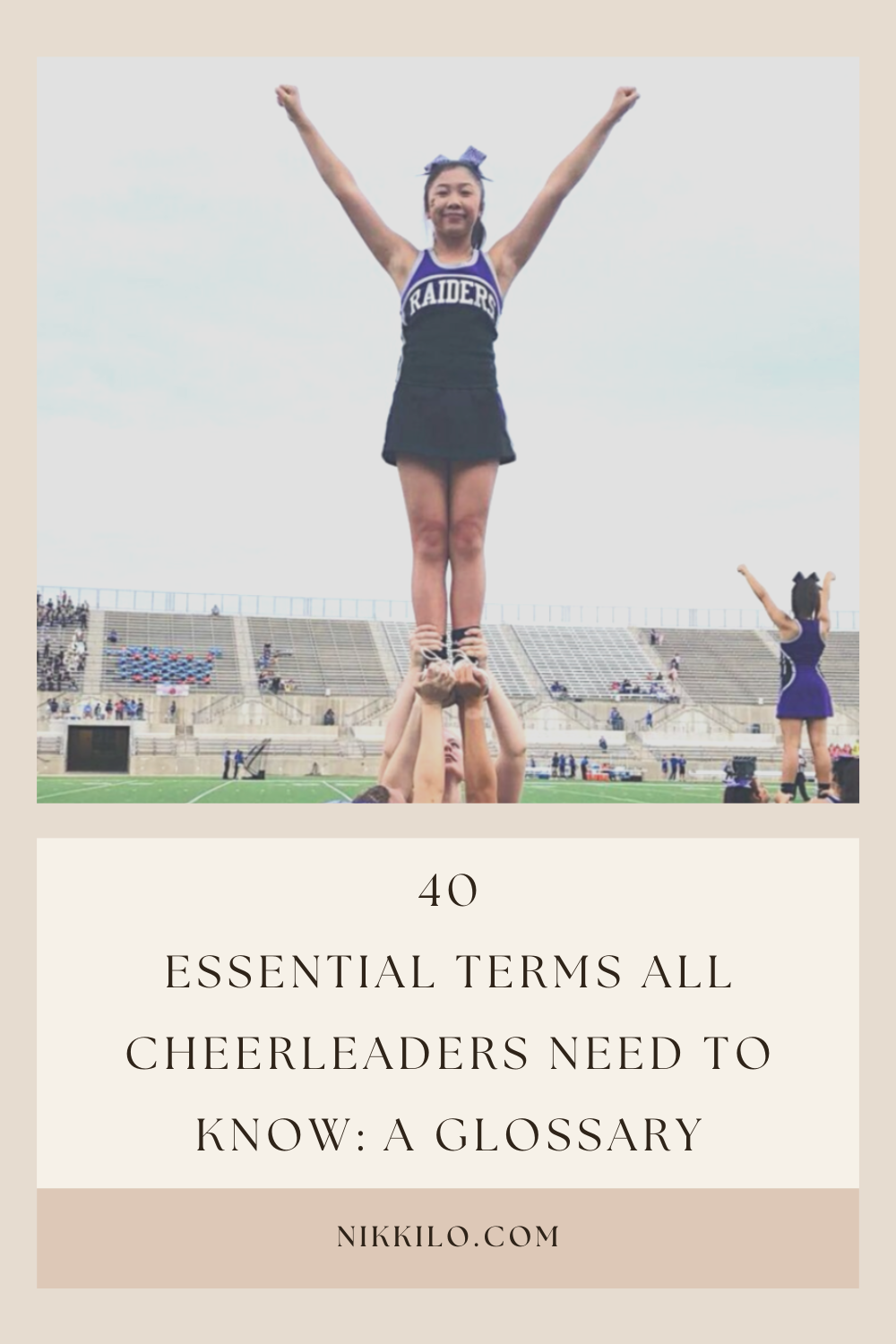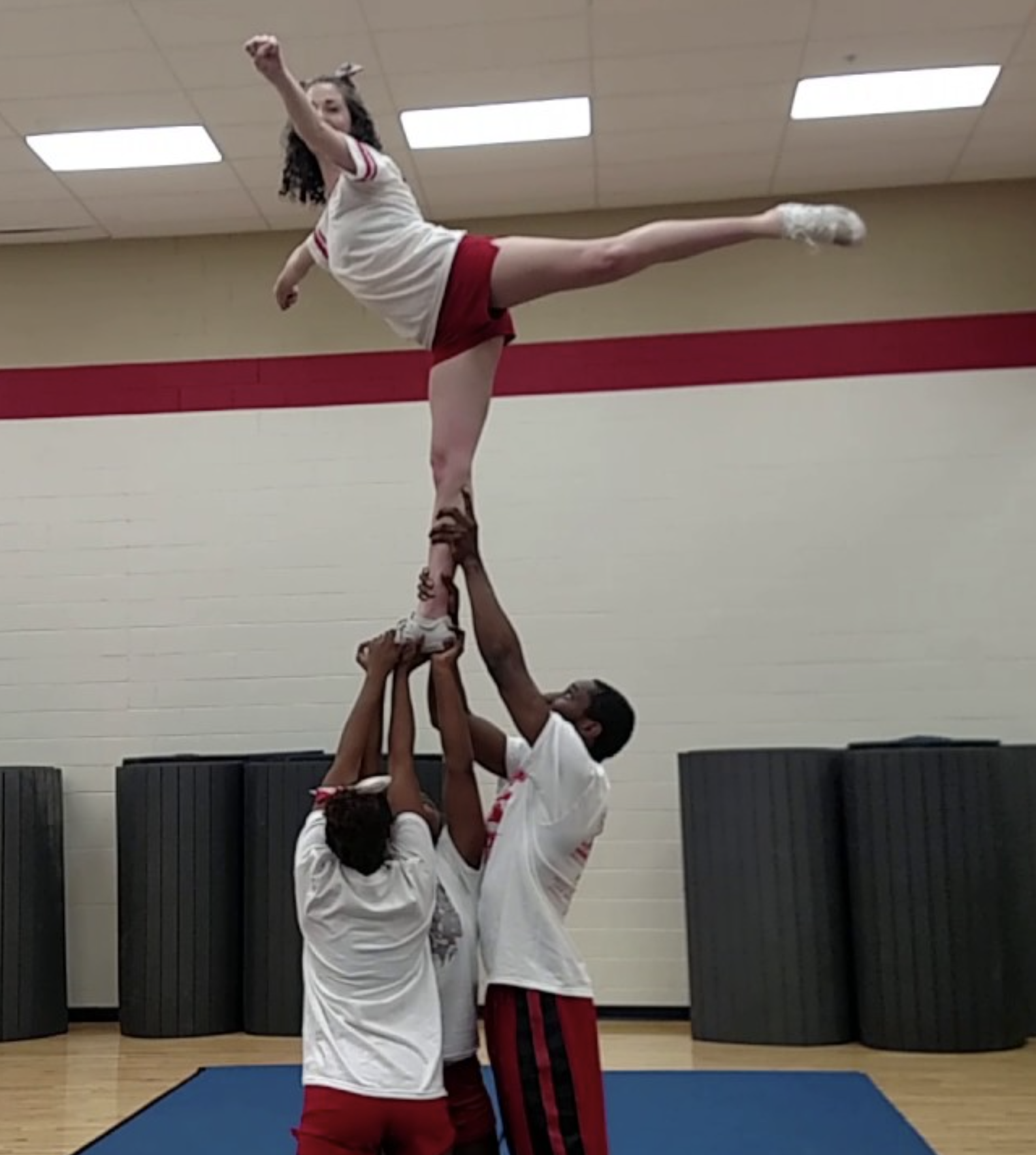40+ Beginner Cheerleading Terms! (With Pictures & Video Examples)
Starting a new sport or activity, especially cheerleading, can be overwhelming! There’s so much to learn and so many terms you’ve never heard before.
New cheerleaders are trying to learn a whole new sport, get acquainted with new teammates and coaches, remember choreography, learn how to do stunts and tumbling moves, and learn cheer vocabulary on top of it all!
That's why I’m here to help! This article lists 40 essential cheerleading terms every cheerleader absolutely needs to know. These are words you’ll hear all the time at every practice, game, and competition you attend.
Be sure to save this post somewhere you can refer back to it when you need to reference something in this mini cheerleading dictionary.
Here are 40 must know cheerleading terms and definitions explained (with pictures and videos for reference)!
Types Of Cheerleading
All-star: a type of rigorous cheerleading that doesn’t cheer for sports teams and focuses only on competing.
This is usually meant for athletes that intend to continue cheering in college or as professionals.
Performance rec/recreation: similar to all-star, it’s a type of competitive cheerleading that doesn’t cheer for sports teams and focuses on competing.
However, performance rec is open to beginners and experienced athletes that want to compete while maintaining harmony with other activities.
Rec/recreation cheer: cheer in which athletes cheer for local youth or rec sports teams, competing is optional.
School cheerleading: a type of cheer that focuses on cheerleading for school sports teams. Competitions are optional.
College cheerleading: a type of cheer for advanced athletes that focuses on cheering at collegiate sports events. They will also participate in cheer and dance competitions or do local performances!
Professional cheerleading: a type of dance-based cheerleading that performs at professional sports events.
Related: The Main Cheerleading Positions EXPLAINED (And Which One Is Right For You)
Stunts
Stunt: any sort of motion where a cheerleader (the flyer) is being lifted or thrown in the air by other cheerleaders (the bases and spotters).
Base: the cheerleaders that hold the flyer’s feet and toss the flyer into the air.
Flyer: the cheerleader being lifted or thrown during stunts.
Spotter: the cheerleader in the back supporting the flyer’s feet and bases’ arms during stunts. They’re primarily responsible for catching the flyer if they fall and ensuring the safety of everyone involved in the stunt.
Basket toss: a stunt in which a flyer is thrown into the air and caught by the bases and spotter in a “basket” position.
Dismount: refers to the completion of a stunt or when a flyer is caught and returned to the ground.
Pyramid: when several stunt groups join together to form a “pyramid” shape with more cheerleaders on the bottom supporting the flyers at the top.
Half-up/prep: a basic type of cheer stunt in which the flyer stands on the bases’ hands which are positioned just under their chins.
Related: Every Type of Cheerleading EXPLAINED And Which One is Right For You!
Motions & Positions
Split: any position in which your legs are about 180 degrees apart and form a straight line. The three types of splits are right, left, and middle. A right split means your right leg is in front, and a left split means your left leg is in front. A middle split or straddle is when your legs are to either side of you, as pictured below.
Heel stretch: a move in which a cheerleader stands on one leg and holds their other leg up as high as they can.
Scorpion: a move in which a cheerleader stands on one leg, reaches behind them, and pulls the other leg up and over their head. Usually, the leg is bent while in this position.
Spike/needle: the same as a scorpion, but a more extreme version in which the cheerleader pulls their leg as close to their head as possible and extends their leg straight.
Arabesque: a position in which a cheerleader stands on one leg and has their other leg fully extended behind them.
Clasp: a cheer motion that’s essentially the cheerleader’s version of a clap.
High V: a cheer position in which your arms are held over your head in a “v” formation with your fists facing out.
Low V: a cheer position in which your arms are held out at your sides in a “v” formation with your fists facing in.
Touchdown: a position in which your arms are held straight over your head next to your ears with your pinkies front-facing.
Low touchdown: a position in which your arms are held straight down to your sides with your pinkies back-facing.
T: a cheer position in which you extend your arms out straight to either side of you.
Half-T: the same as a “T” but bend your arms inwards.
Related: What To Bring To Cheer Practice (9 Essentials Every Cheerleader NEEDS)
Tumbling
Tumbling: any sort of acrobatic or gymnastics moves like cartwheels, tucks, handsprings, and handstands.
Aerial: a cartwheel where your hands and feet completely leave the ground. Essentially, a no-handed cartwheel.
Back handspring: a tumbling move in which you throw yourself backwards, land on your hands, and propel your body to a standing position.
Front handspring: the reverse version of a back handspring. Basically, a handstand in which you use your arms to propel your legs over your head to land upright on your feet.
Front walkover: similar to a front handspring but your hands or feet are touching the ground at all times. Start in a handstand and kick your feet over your head to land in a bridge and stand up.
Back walkover: the opposite of a front walkover. Arch backward into a bridge and kick your feet over your head. Once your feet touch the ground, stand up.
Bridge: when your back is arched and you’re holding up your weight with your arms and legs.
Back tuck: a backflip. The cheerleader will start from a standing position, jump, bring their feet over their head, and land upright.
Front tuck: the opposite of a back tuck, essentially a front flip.
Round-off: a basic tumbling move in which the cheerleader starts similar to a cartwheel but snaps their legs together and springs into an upright landing facing the opposite direction they started in.
Related: Essential Stretches All Cheerleaders Should Be Doing Regularly
Jumps
Pike jump: a type of cheerleading jump in which both legs are extended out in front of your body at a 90-degree angle and your arms reach towards your feet.
Toe touch: a type of jump that’s essentially a middle split/straddle in mid-air. Both of your legs are raised and out to either side of your body.
Front hurdler: a type of jump in which one leg is raised in front of you and you extend your arms in front of your body to reach your foot.
Your bottom leg bends beneath your body.
Side hurdler: similar to a front hurdler but your font and back legs will be on more of a diagonal.
There you have it! This post talked about 40 absolutely essential cheerleading terms for beginners that you’ll hear at every practice.
This post is a perfect starting point for beginner cheerleaders or someone who's interested in trying out cheer and learning more about the sport. Thanks for reading “40+ Beginner Cheerleading Terms! (With Pictures & Video Examples).”
For handmade digital art prints, icon packs, wallpapers, & more designed by me, be sure to stop by my digital boutique: Designed By Nikki Lo.
Connect with me!

















